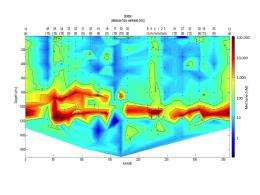Scientists document fate of deep hydrocarbon plumes in Gulf oil spill

(PhysOrg.com) -- In the aftermath of the Deepwater Horizon disaster in the Gulf of Mexico, a team of scientists led by UC Santa Barbara's David Valentine and Texas A&M University's John Kessler embarked on a research cruise with an urgent mission: determining the fate and impact of hydrocarbon gases escaping from a deep-water oil spill.
The spill provided a rare opportunity for Valentine, a professor in the Department of Earth Science at UCSB, and Kessler, an assistant professor in the Department of Oceanography at Texas A&M, to study the behavior of methane and other natural gases in the murky depths of the Gulf of Mexico. The results of their research are published in a new paper, "Propane respiration jump-starts microbial response to a deep oil spill," published today (Sept. 16) as an advance online release in the journal Science.
"We were fortunate to have the expertise and opportunity to get to the heart of this national disaster and to contribute meaningfully to understanding what was happening in the deep ocean during the spill," Valentine, the lead author, said. "As a scholar, it is rare that your intellectual domain comes so abruptly to the forefront of the national consciousness. Circumstances aside, I feel that it reflects well on our country's scientific and educational systems that we foster such expertise."
The scientists conducted their tests June 11-21, less than two months after the Deepwater Horizon platform exploded, causing the largest marine oil spill in history. Their team conducted its experiments as close as 1,500 feet from the epicenter of the active spill, using underwater sampling devices and sensors to measure hydrocarbons and oxygen depletion at various depths, and to collect water samples to study the biodegradation of natural gas and the associated blooms of bacteria.
Their research was funded by the National Science Foundation and the Department of Energy, and was conducted on the Research Vessel Cape Hatteras.
The team reported several new findings in their study. At the time they sampled in June, they identified four large plumes of suspended hydrocarbons that had been moved by deep currents in different directions from the leaking well. Since each plume originated from the well at a different time, the scientists were able to compare the chemicals and isotopes to determine what compounds were preferentially respired by the bacteria.
What they found was surprising: Three specific hydrocarbon gases — ethane, propane and butane — were responsible for most of the respiration and oxygen loss observed in the deep plumes. They further identified the dominant bacteria present in the plumes and suggested some of the organisms were targeting the natural gases.
The team also found that methane gas, the single most abundant compound spilled by Deepwater Horizon, was initially consumed very slowly, but that the rate increased as other gases were depleted. They estimate that ultimately two-thirds of the bacterial productivity and respiration in the deep-water plumes will be linked to natural gas.
"Because the Deepwater Horizon rig accident occurred almost a mile deep, the slow migration of petroleum from that depth allowed time for dissolution of volatile hydrocarbons such as methane, ethane, propane, and butane," Valentine said. "Had it occurred in shallower water, these gases would have certainly escaped into the atmosphere. This gas trapping will go down as one of the distinguishing hallmarks of a deep oil spill."
Kessler added: "Dissolving these gases in the ocean is a bit of a double-edged sword. On the one hand, these gases influenced both the air quality and the radiative budget of the atmosphere, so trapping them within the ocean is a good thing. But their eventual marine biodegradation leads to the consumption of dissolved oxygen, which is an annual problem in the northern Gulf of Mexico. Fingerprinting the main chemicals responsible for the majority of the oxygen reductions associated with this spill is extremely helpful as we decide how to deal with this and other such events."
The scientists found that propane and ethane were the primary foodstuffs for microbial respiration, accounting for up to 70 percent of the observed oxygen depletion in fresh plumes. They further suggest that butane accounts for much of the remainder. They learned that the ratio of methane to ethane and propane varied substantially throughout the deep plumes and served as the indicator of bacterial activity.
The scientists concluded that deep oil and gas spills elicit a distinctive microbial response because of the trapped gases. They also suggest that bacterial blooms may turn their attention to oil after the gas is depleted as many bacteria can cross over with their metabolism. However, they caution that the metabolism of these bugs has not been established and that the specific bacteria that bloomed may only target specific compounds in oil.
While the results of this study suggest that ethane, propane and butane plumes may disappear quickly, methane may not, due to its relatively slow consumption rate. This suggests the potential for a much longer-lived methane plume in the deep ocean, with unknown consequences. To address this issue, Valentine and Kessler are currently leading another expedition supported by the National Oceanic and Atmospheric Administration in an attempt to determine the longer-term fate of methane and oil in the deep Gulf waters.
Provided by Texas A&M University















